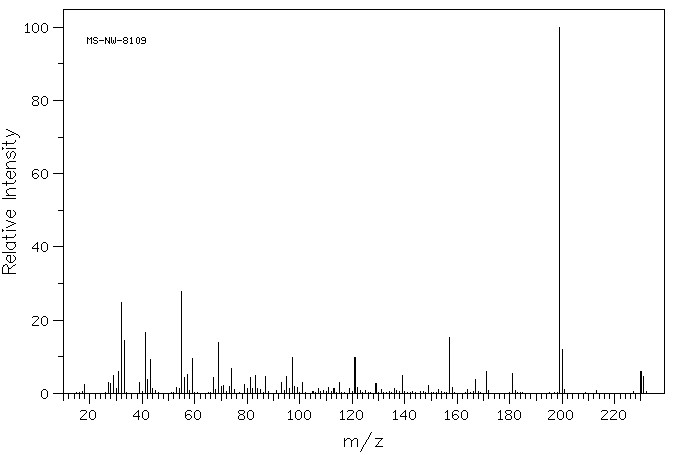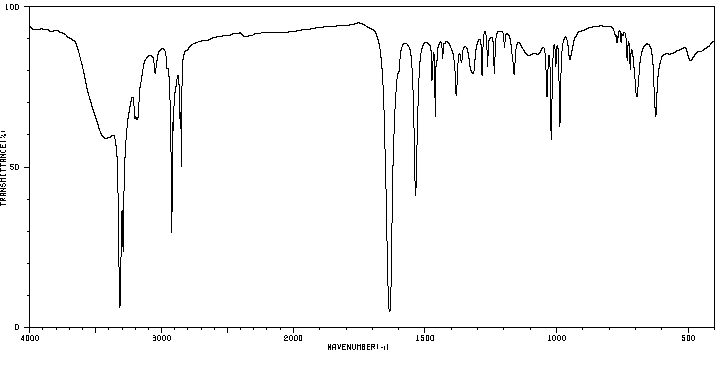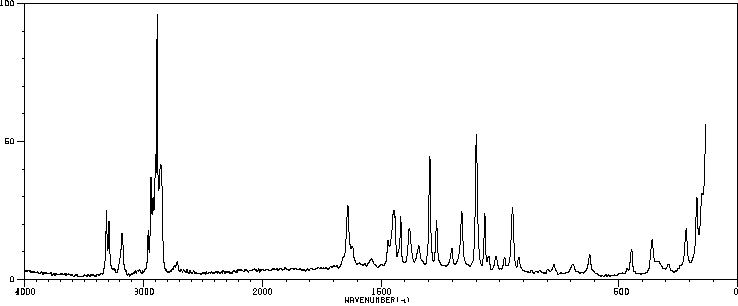癸二酰肼 | 925-83-7
中文名称
癸二酰肼
中文别名
癸烷二肼;癸肼;癸二酸二酰肼
英文名称
sebacic acid dihydrazide
英文别名
sebacic dihydrazide;Sebacinsaeure-dihydrazid;decanedihydrazide
CAS
925-83-7
化学式
C10H22N4O2
mdl
MFCD00039763
分子量
230.31
InChiKey
ZWLIYXJBOIDXLL-UHFFFAOYSA-N
BEILSTEIN
——
EINECS
——
-
物化性质
-
计算性质
-
ADMET
-
安全信息
-
SDS
-
制备方法与用途
-
上下游信息
-
文献信息
-
表征谱图
-
同类化合物
-
相关功能分类
-
相关结构分类
物化性质
-
熔点:186 °C
-
沸点:372.3°C (rough estimate)
-
密度:1.0881 (rough estimate)
-
LogP:-0.8 at 20℃ and pH7.3-7.4
计算性质
-
辛醇/水分配系数(LogP):-0.7
-
重原子数:16
-
可旋转键数:9
-
环数:0.0
-
sp3杂化的碳原子比例:0.8
-
拓扑面积:110
-
氢给体数:4
-
氢受体数:4
安全信息
-
危险等级:IRRITANT
-
危险类别码:R36/37/38
-
海关编码:2928000090
-
包装等级:II
-
危险类别:4.1
-
危险性防范说明:P210,P240,P261,P264,P270,P271,P280,P302+P352,P304+P340,P305+P351+P338,P312,P330,P362,P370+P378,P403+P233,P501
-
危险品运输编号:1325
-
危险性描述:H228,H302,H315,H319,H335
-
储存条件:存放于惰性气体中,避免接触空气。
SDS
癸二酰肼 修改号码:5
模块 1. 化学品
产品名称: Sebacic Dihydrazide
修改号码: 5
模块 2. 危险性概述
GHS分类
物理性危害 未分类
健康危害
急性毒性(经口) 第5级
环境危害 未分类
GHS标签元素
图标或危害标志 无
信号词 警告
危险描述 吞咽可能有害。
防范说明
[急救措施] 若感不适:呼叫解毒中心/医生。
模块 3. 成分/组成信息
单一物质/混和物 单一物质
化学名(中文名): 癸二酰肼
百分比: >95.0%(T)
CAS编码: 925-83-7
俗名: Decanediohydrazide , Sebacohydrazide
分子式: C10H22N4O2
模块 4. 急救措施
吸入: 将受害者移到新鲜空气处,保持呼吸通畅,休息。若感不适立即呼叫解毒中心/医生。
皮肤接触: 立即去除/脱掉所有被污染的衣物。用大量肥皂和水轻轻洗。
若皮肤刺激或发生皮疹:求医/就诊。
眼睛接触: 用水小心清洗几分钟。如果方便,易操作,摘除隐形眼镜。继续清洗。
如果眼睛刺激:求医/就诊。
食入: 若感不适,呼叫解毒中心/医生。漱口。
紧急救助者的防护: 救援者需要穿戴个人防护用品,比如橡胶手套和气密性护目镜。
癸二酰肼 修改号码:5
模块 5. 消防措施
合适的灭火剂: 干粉,泡沫,雾状水,二氧化碳
特殊危险性: 一旦发生火警,有爆炸的危险。由于爆炸的危险,远距离灭火。
小心,燃烧或高温下可能分解产生毒烟。
特定方法: 从上风处灭火,根据周围环境选择合适的灭火方法。
非相关人员应该撤离至安全地方。
周围一旦着火:喷水,保持容器冷却。如果安全,消除一切火源。
消防员的特殊防护用具: 灭火时,一定要穿戴个人防护用品。
模块 6. 泄漏应急处理
个人防护措施,防护用具, 使用个人防护用品。远离溢出物/泄露处并处在上风处。
紧急措施: 泄露区应该用安全带等圈起来,控制非相关人员进入。
环保措施: 防止进入下水道。
控制和清洗的方法和材料: 清扫收集粉尘,封入密闭容器。注意切勿分散。附着物或收集物应该立即根据合适的
法律法规处置。
模块 7. 操作处置与储存
处理
技术措施: 在通风良好处进行处理。穿戴合适的防护用具。切勿引起泄漏、溢出或分散。切勿产
生不必要的蒸气。远离热源/火花/明火/热表面。禁烟。采取措施防止静电积累。使用
防爆设备。避免冲击和摩擦。处理后彻底清洗双手和脸。
注意事项: 如果粉尘或浮质产生,使用局部排气。
操作处置注意事项: 避免接触皮肤、眼睛和衣物。
贮存
储存条件: 保持容器密闭。存放于凉爽、阴暗处。
存放于惰性气体环境中。
确保容器不会受到未测影响,比如跌落或脱落。
远离不相容的材料比如氧化剂存放。
气敏
包装材料: 依据法律。
模块 8. 接触控制和个体防护
工程控制: 尽可能安装封闭体系或局部排风系统,操作人员切勿直接接触。同时安装淋浴器和洗
眼器。
个人防护用品
呼吸系统防护: 防尘面具。依据当地和政府法规。
手部防护: 防护手套。
眼睛防护: 安全防护镜。如果情况需要,佩戴面具。
皮肤和身体防护: 防护服。如果情况需要,穿戴防护靴。
模块 9. 理化特性
外形(20°C): 固体
外观: 晶体-粉末
颜色: 白色类白色
气味: 无资料
pH: 无数据资料
熔点:
186°C
沸点/沸程 无资料
闪点: 无资料
爆炸特性
爆炸下限: 无资料
癸二酰肼 修改号码:5
模块 9. 理化特性
爆炸上限: 无资料
密度: 无资料
溶解度:
[水] 无资料
[其他溶剂]
溶于: 热乙酸
模块 10. 稳定性和反应性
化学稳定性: 一般情况下稳定。
危险反应的可能性: 热、撞击、摩擦等条件下可能爆炸分解。
避免接触的条件: 热, 冲击, 摩擦
须避免接触的物质 氧化剂
危险的分解产物: 一氧化碳, 二氧化碳, 氮氧化物 (NOx)
模块 11. 毒理学信息
急性毒性: orl-rat LD50:2500 mg/kg
ivn-mus LD50:56 mg/kg
对皮肤腐蚀或刺激: 无资料
对眼睛严重损害或刺激: 无资料
生殖细胞变异原性: 无资料
致癌性:
IARC = 无资料
NTP = 无资料
生殖毒性: 无资料
RTECS 号码: VS1225000
模块 12. 生态学信息
生态毒性:
鱼类: 无资料
甲壳类: 无资料
藻类: 无资料
残留性 / 降解性: 无资料
潜在生物累积 (BCF): 无资料
土壤中移动性
log水分配系数: 无资料
土壤吸收系数 (Koc): 无资料
亨利定律 无资料
constaNT(PaM3/mol):
模块 13. 废弃处置
如果可能,回收处理。请咨询当地管理部门和专家。建议在可燃溶剂中溶解混合,然后在装有后燃和洗涤装置的化
学焚烧炉中慢慢焚烧。如果一次性焚烧大量物质,可能发生爆炸。废弃处置时请遵守国家、地区和当地的所有法规
。
模块 14. 运输信息
联合国分类: 与联合国分类标准不一致
UN编号: 未列明
癸二酰肼 修改号码:5
模块 15. 法规信息
《危险化学品安全管理条例》(2002年1月26日国务院发布,2011年2月16日修订): 针对危险化学品的安全使用、
生产、储存、运输、装卸等方面均作了相应的规定。
模块16 - 其他信息
N/A
模块 1. 化学品
产品名称: Sebacic Dihydrazide
修改号码: 5
模块 2. 危险性概述
GHS分类
物理性危害 未分类
健康危害
急性毒性(经口) 第5级
环境危害 未分类
GHS标签元素
图标或危害标志 无
信号词 警告
危险描述 吞咽可能有害。
防范说明
[急救措施] 若感不适:呼叫解毒中心/医生。
模块 3. 成分/组成信息
单一物质/混和物 单一物质
化学名(中文名): 癸二酰肼
百分比: >95.0%(T)
CAS编码: 925-83-7
俗名: Decanediohydrazide , Sebacohydrazide
分子式: C10H22N4O2
模块 4. 急救措施
吸入: 将受害者移到新鲜空气处,保持呼吸通畅,休息。若感不适立即呼叫解毒中心/医生。
皮肤接触: 立即去除/脱掉所有被污染的衣物。用大量肥皂和水轻轻洗。
若皮肤刺激或发生皮疹:求医/就诊。
眼睛接触: 用水小心清洗几分钟。如果方便,易操作,摘除隐形眼镜。继续清洗。
如果眼睛刺激:求医/就诊。
食入: 若感不适,呼叫解毒中心/医生。漱口。
紧急救助者的防护: 救援者需要穿戴个人防护用品,比如橡胶手套和气密性护目镜。
癸二酰肼 修改号码:5
模块 5. 消防措施
合适的灭火剂: 干粉,泡沫,雾状水,二氧化碳
特殊危险性: 一旦发生火警,有爆炸的危险。由于爆炸的危险,远距离灭火。
小心,燃烧或高温下可能分解产生毒烟。
特定方法: 从上风处灭火,根据周围环境选择合适的灭火方法。
非相关人员应该撤离至安全地方。
周围一旦着火:喷水,保持容器冷却。如果安全,消除一切火源。
消防员的特殊防护用具: 灭火时,一定要穿戴个人防护用品。
模块 6. 泄漏应急处理
个人防护措施,防护用具, 使用个人防护用品。远离溢出物/泄露处并处在上风处。
紧急措施: 泄露区应该用安全带等圈起来,控制非相关人员进入。
环保措施: 防止进入下水道。
控制和清洗的方法和材料: 清扫收集粉尘,封入密闭容器。注意切勿分散。附着物或收集物应该立即根据合适的
法律法规处置。
模块 7. 操作处置与储存
处理
技术措施: 在通风良好处进行处理。穿戴合适的防护用具。切勿引起泄漏、溢出或分散。切勿产
生不必要的蒸气。远离热源/火花/明火/热表面。禁烟。采取措施防止静电积累。使用
防爆设备。避免冲击和摩擦。处理后彻底清洗双手和脸。
注意事项: 如果粉尘或浮质产生,使用局部排气。
操作处置注意事项: 避免接触皮肤、眼睛和衣物。
贮存
储存条件: 保持容器密闭。存放于凉爽、阴暗处。
存放于惰性气体环境中。
确保容器不会受到未测影响,比如跌落或脱落。
远离不相容的材料比如氧化剂存放。
气敏
包装材料: 依据法律。
模块 8. 接触控制和个体防护
工程控制: 尽可能安装封闭体系或局部排风系统,操作人员切勿直接接触。同时安装淋浴器和洗
眼器。
个人防护用品
呼吸系统防护: 防尘面具。依据当地和政府法规。
手部防护: 防护手套。
眼睛防护: 安全防护镜。如果情况需要,佩戴面具。
皮肤和身体防护: 防护服。如果情况需要,穿戴防护靴。
模块 9. 理化特性
外形(20°C): 固体
外观: 晶体-粉末
颜色: 白色类白色
气味: 无资料
pH: 无数据资料
熔点:
186°C
沸点/沸程 无资料
闪点: 无资料
爆炸特性
爆炸下限: 无资料
癸二酰肼 修改号码:5
模块 9. 理化特性
爆炸上限: 无资料
密度: 无资料
溶解度:
[水] 无资料
[其他溶剂]
溶于: 热乙酸
模块 10. 稳定性和反应性
化学稳定性: 一般情况下稳定。
危险反应的可能性: 热、撞击、摩擦等条件下可能爆炸分解。
避免接触的条件: 热, 冲击, 摩擦
须避免接触的物质 氧化剂
危险的分解产物: 一氧化碳, 二氧化碳, 氮氧化物 (NOx)
模块 11. 毒理学信息
急性毒性: orl-rat LD50:2500 mg/kg
ivn-mus LD50:56 mg/kg
对皮肤腐蚀或刺激: 无资料
对眼睛严重损害或刺激: 无资料
生殖细胞变异原性: 无资料
致癌性:
IARC = 无资料
NTP = 无资料
生殖毒性: 无资料
RTECS 号码: VS1225000
模块 12. 生态学信息
生态毒性:
鱼类: 无资料
甲壳类: 无资料
藻类: 无资料
残留性 / 降解性: 无资料
潜在生物累积 (BCF): 无资料
土壤中移动性
log水分配系数: 无资料
土壤吸收系数 (Koc): 无资料
亨利定律 无资料
constaNT(PaM3/mol):
模块 13. 废弃处置
如果可能,回收处理。请咨询当地管理部门和专家。建议在可燃溶剂中溶解混合,然后在装有后燃和洗涤装置的化
学焚烧炉中慢慢焚烧。如果一次性焚烧大量物质,可能发生爆炸。废弃处置时请遵守国家、地区和当地的所有法规
。
模块 14. 运输信息
联合国分类: 与联合国分类标准不一致
UN编号: 未列明
癸二酰肼 修改号码:5
模块 15. 法规信息
《危险化学品安全管理条例》(2002年1月26日国务院发布,2011年2月16日修订): 针对危险化学品的安全使用、
生产、储存、运输、装卸等方面均作了相应的规定。
模块16 - 其他信息
N/A
制备方法与用途
上下游信息
-
下游产品
中文名称 英文名称 CAS号 化学式 分子量 —— N,N'-diacetylsebacic acid dihydrazide 7450-72-8 C14H26N4O4 314.385 —— 10-(N'-Isobutyryl-hydrazino)-10-oxo-decanoic acid N'-isobutyryl-hydrazide 132501-09-8 C18H34N4O4 370.492 —— 10-[N'-(2,2-Dimethyl-propionyl)-hydrazino]-10-oxo-decanoic acid N'-(2,2-dimethyl-propionyl)-hydrazide 132501-10-1 C20H38N4O4 398.546
反应信息
-
作为反应物:描述:癸二酰肼 在 三氯氧磷 作用下, 以 乙腈 为溶剂, 反应 7.0h, 生成 2-(Phenoxymethyl)-5-[8-[5-(phenoxymethyl)-1,3,4-oxadiazol-2-yl]octyl]-1,3,4-oxadiazole参考文献:名称:Synthesis, Biological Evaluation, and Three-Dimensional Quantitative Structure−Activity Relationship Study of Small-Molecule Positive Modulators of Adrenomedullin摘要:Adrenomedullin (AM) is a peptide hormone implicated in blood pressure regulation and in the pathophysiology of several diseases such as hypertension, cancer, diabetes, and renal disorders, becoming an interesting new target for the development of drugs. In a recent high-throughput screening study, a positive modulator with a bistriazole structure has been identified.(1) In this work, a new series of structurally related compounds has been synthesized by reaction of phenoxyacetic acid with the corresponding dihydrazide, followed by treatment of the formed bisoxadiazoles with benzylamine. The affinity toward AM of the lead compound, and a structurally related family obtained from the small-molecule NCI library together with the synthesized series, has been determined. A three-dimensional quantitative structure-activity relationship (3D-QSAR) study and conformational and molecular dynamics simulations have shown that the presence of a free NH and a phenyl group is essential for the interaction of these compounds with AM.DOI:10.1021/jm050021+
-
作为产物:参考文献:名称:Steller, Journal fur praktische Chemie (Leipzig 1954), 1900, vol. <2>62, p. 216摘要:DOI:
文献信息
-
Diacyl acid dihydrazides作者:Mahmoud Al-Talib、Hasan Tashtoush、Nedal OdehDOI:10.1002/mrc.1260281215日期:1990.12N,N′-Diacyl acid dihydrazides were prepaed by the reaction of acid dihydazides with two equivalents of acyl chlorides. The structures of these compounds were elucidated by 1H and 13C NMR spectroscopy.
-
A Strategy to Synthesize Molecular Knots and Links Using the Hydrophobic Effect作者:Fabien B. L. Cougnon、Kenji Caprice、Marion Pupier、Antonio Bauzá、Antonio FronteraDOI:10.1021/jacs.8b05220日期:2018.10.3hydrophobic surface area in contact with water. Therefore, the size, geometry, and rigidity of the initial building blocks can be exploited to control the formation of a specific topology. We illustrate the validity of this concept with the syntheses of a Hopf link, a Solomon link, and a trefoil knot. This latter molecule, whose self-assembly is templated by halides, binds iodide with high affinity in合成分子结和链接的常规方法主要依赖于金属模板。我们在这里提出了一种替代策略,该策略使用疏水效应来驱动水中复杂互锁结构的形成。我们设计了一个可以产生结和链接的水性动态组合系统。在这个系统中,拓扑复杂的大环的自组装只有在其所有组分的最佳填充最小化与水接触的疏水表面积时才在热力学上有利。因此,可以利用初始构建块的大小、几何形状和刚度来控制特定拓扑的形成。我们通过合成一个 Hopf 链接、一个 Solomon 链接和一个三叶结来说明这个概念的有效性。后一种分子,其自组装由卤化物模板化,在水中以高亲和力结合碘化物。总的来说,这项工作为拓扑复杂分子的合成带来了新的视角:可以有意利用疏溶剂效应来指导节点和链接的高效和选择性自组装。
-
一种多硫代酰肼型重金属螯合剂的制备方法
-
Solubilization and Targeted Delivery of Drugs With Self-Assembling Amphiphilic Polymers申请人:Diwan Anil公开号:US20100260743A1公开(公告)日:2010-10-14There are provided amphiphilic biodegradable copolymers comprising a hydrophilic backbone with pendant aliphatic groups as the hydrophobic component. The polymers form nanoscale molecular aggregates in aqueous environments, which have hydrophobic interiors that are capable of solubilizing insoluble organic compounds such as drugs, vitamins, dyes, and imaging agents. The polymers optionally feature reactive functional groups that provide attachment points for antibodies, ligands, and other targeting moieties useful for the targeted delivery of drugs and imaging agents.
-
一种受阻胺化合物及其制备方法和用途
表征谱图
-
氢谱1HNMR
-
质谱MS
-
碳谱13CNMR
-
红外IR
-
拉曼Raman
-
峰位数据
-
峰位匹配
-
表征信息
同类化合物
(甲基3-(二甲基氨基)-2-苯基-2H-azirene-2-羧酸乙酯)
(±)-盐酸氯吡格雷
(±)-丙酰肉碱氯化物
(d(CH2)51,Tyr(Me)2,Arg8)-血管加压素
(S)-(+)-α-氨基-4-羧基-2-甲基苯乙酸
(S)-阿拉考特盐酸盐
(S)-赖诺普利-d5钠
(S)-2-氨基-5-氧代己酸,氢溴酸盐
(S)-2-[[[(1R,2R)-2-[[[3,5-双(叔丁基)-2-羟基苯基]亚甲基]氨基]环己基]硫脲基]-N-苄基-N,3,3-三甲基丁酰胺
(S)-2-[3-[(1R,2R)-2-(二丙基氨基)环己基]硫脲基]-N-异丙基-3,3-二甲基丁酰胺
(S)-1-(4-氨基氧基乙酰胺基苄基)乙二胺四乙酸
(S)-1-[N-[3-苯基-1-[(苯基甲氧基)羰基]丙基]-L-丙氨酰基]-L-脯氨酸
(R)-乙基N-甲酰基-N-(1-苯乙基)甘氨酸
(R)-丙酰肉碱-d3氯化物
(R)-4-N-Cbz-哌嗪-2-甲酸甲酯
(R)-3-氨基-2-苄基丙酸盐酸盐
(R)-1-(3-溴-2-甲基-1-氧丙基)-L-脯氨酸
(N-[(苄氧基)羰基]丙氨酰-N〜5〜-(diaminomethylidene)鸟氨酸)
(6-氯-2-吲哚基甲基)乙酰氨基丙二酸二乙酯
(4R)-N-亚硝基噻唑烷-4-羧酸
(3R)-1-噻-4-氮杂螺[4.4]壬烷-3-羧酸
(3-硝基-1H-1,2,4-三唑-1-基)乙酸乙酯
(2S,4R)-Boc-4-环己基-吡咯烷-2-羧酸
(2S,3S,5S)-2-氨基-3-羟基-1,6-二苯己烷-5-N-氨基甲酰基-L-缬氨酸
(2S,3S)-3-((S)-1-((1-(4-氟苯基)-1H-1,2,3-三唑-4-基)-甲基氨基)-1-氧-3-(噻唑-4-基)丙-2-基氨基甲酰基)-环氧乙烷-2-羧酸
(2S)-2,6-二氨基-N-[4-(5-氟-1,3-苯并噻唑-2-基)-2-甲基苯基]己酰胺二盐酸盐
(2S)-2-氨基-N,3,3-三甲基-N-(苯甲基)丁酰胺
(2S)-2-氨基-3-甲基-N-2-吡啶基丁酰胺
(2S)-2-氨基-3,3-二甲基-N-(苯基甲基)丁酰胺,
(2S)-2-氨基-3,3-二甲基-N-2-吡啶基丁酰胺
(2S,4R)-1-((S)-2-氨基-3,3-二甲基丁酰基)-4-羟基-N-(4-(4-甲基噻唑-5-基)苄基)吡咯烷-2-甲酰胺盐酸盐
(2R,3'S)苯那普利叔丁基酯d5
(2R)-2-氨基-3,3-二甲基-N-(苯甲基)丁酰胺
(2-氯丙烯基)草酰氯
(1S,3S,5S)-2-Boc-2-氮杂双环[3.1.0]己烷-3-羧酸
(1R,5R,6R)-5-(1-乙基丙氧基)-7-氧杂双环[4.1.0]庚-3-烯-3-羧酸乙基酯
(1R,4R,5S,6R)-4-氨基-2-氧杂双环[3.1.0]己烷-4,6-二羧酸
齐特巴坦
齐德巴坦钠盐
齐墩果-12-烯-28-酸,2,3-二羟基-,苯基甲基酯,(2a,3a)-
齐墩果-12-烯-28-酸,2,3-二羟基-,羧基甲基酯,(2a,3b)-(9CI)
黄酮-8-乙酸二甲氨基乙基酯
黄荧菌素
黄体生成激素释放激素(1-6)
黄体生成激素释放激素 (1-5) 酰肼
黄体瑞林
麦醇溶蛋白
麦角硫因
麦芽聚糖六乙酸酯
麦根酸









